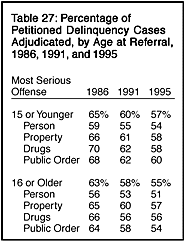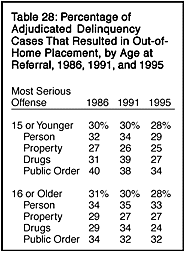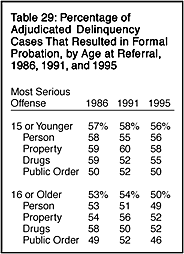|
Age at Referral Judicial Decision and Disposition
Once petitioned, juveniles age 15 and younger were slightly more likely to be adjudicated than were older youth (57% versus 55% in 1995). This pattern was found in all four offense categories (table 27). Both age groups reflected the general decline between 1986 and 1995 in the proportion of formally handled cases that resulted in adjudication. The percentage of petitioned delinquency cases resulting in adjudication declined from 65% to 57% among younger youth and from 63% to 55% among older youth. The likelihood of adjudication was lower for both age groups in all offense categories. The proportion of adjudicated cases placed outside the home was just under 30% for both age groups (table 28). Compared with 1986, the use of placement for adjudicated delinquency cases was relatively unchanged in 1995 for person offense and property offense cases for both younger and older youth. However, there was substantial change in the use of placement for drug offense cases between 1986 and 1995. Among both age groups, the use of placement in adjudicated drug cases increased between 1986 and 1991 and then fell between 1991 and 1995.
Once adjudicated, the likelihood that a juvenile court would place a delinquent youth on formal probation was slightly greater for younger youth. In 1995, 56% of adjudicated cases involving younger youth resulted in probation compared with 50% of cases involving older youth (table 29). With the exception of drug aw violation cases, changes in the use of probation between 1986 and 1995 were relatively minor for both age groups. The use of probation for drug cases in 1995 was considerably lower than in 1986 for both younger and older youth.
|



